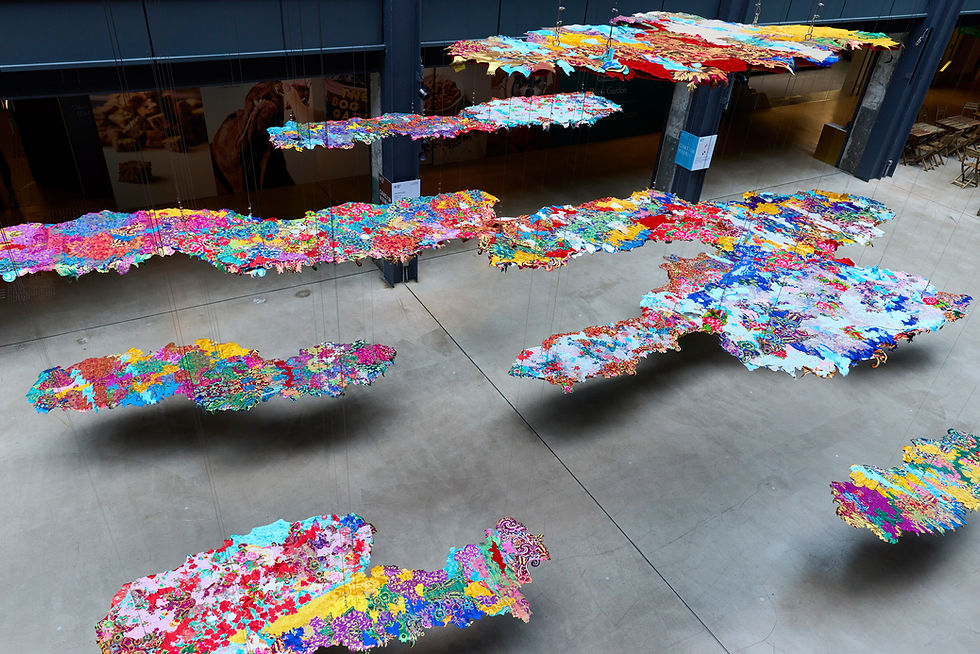A conversation with Jun-Jieh Wang, Director of Taipei Fine Arts Museum, about 13th Taipei Biennial "Small World": A Reflection on Contemporary Challenges
- Gen de Art

- Mar 14, 2024
- 4 min read
The 13th edition of the Taipei Biennial, organized by the Taipei Fine Arts Museum (TFAM), presents a unique exploration of the contemporary world through the lens of art. Titled "Small World," this year's Biennial runs from November 18, 2023, to March 24, 2024, and is a response to the recent global pandemic, featuring over 50 international and local artists and musicians. Jun-Jieh Wang, the Director of TFAM, shares his insights on the theme, the role of the museum, and the evolving Taiwanese art scene.

You've been actively involved in the international contemporary art scene for many years. How has your extensive experience shaped your approach to curating the Taipei Biennial, and what unique perspectives do you bring to this year's edition?
This edition is different from the past in that we have undergone a major transformation as a result of the pandemic. The pandemic has changed many things, including our perspectives on how the world operates, our relationships with others, and even our political perspectives, including discussions on geopolitics and globalization. In response to these circumstances, the Taipei Biennial, which has long been contemplating the relationship between culture, art, and the development of the world, strongly resonates with this year's theme of "Small World." One slight difference from previous editions of the Taipei Biennial lies in how the exhibition is approached. In the past, we emphasized the curator's unique academic perspective and the artistic approach, with curatorial discourse playing a significant role. However, in this year's Biennial, we are contemplating the idea of the "Small World" as proposed by the three curators, which is, to a considerable extent, a response to the current state of the world we are facing. Whether it is a pandemic or war, it is a more direct response to the present environment, making it a little different from previous editions.

Taipei Fine Arts Museum (TFAM) plays a pivotal role in organizing the Taipei Biennial. Could you share with us the overarching goals and mission of TFAM in the context of this Biennial, and how it has evolved over the years?
The Taipei Biennial was established in 1998 and is one of the early medium-sized Biennials in Asia, second only to the Gwangju Biennale. The Taipei Biennial is coordinated and curated by the Taipei Fine Arts Museum, which sets us apart from other international biennials that may be organized by specific foundations or organizations. We collaborate with institutional and curatorial teams to create thematic content that is integrated with the biennial's presentation, thereby creating an exhibition that responds to contemporary art. Led by the Taipei Fine Arts Museum, the Taipei Biennial continually deepens its propositions with each edition, and through refined curatorial combinations and contemporary artworks, we strive to resonate with the development of the world we face.
Could you tell us more about the concept and theme of this year's edition, and how do they reflect the current state of contemporary art in Taiwan and the broader international art scene?
Co-curated by independent curator Freya Chou, director and curator of Beirut Art Centre Reem Shadid, and New York-based senior writer and editor Brian Kuan Wood, the 13th edition of the Taipei Biennial brings together over 50 international and local artists and musicians, transforming the museum into a space of listening, gathering, improvising, and exploring alternative ways to perceive and apply what we learned from the recent pandemic. The title "Small World" suggests both a promise and a threat: a promise of greater control over one's own life, and a threat of isolation from a larger community following a global pandemic. Through a series of presentations that comprise sound, music, moving images, photography, video, paintings, sculptures, and installations, "Small World" presents audiences with the dilemma faced by us and our societies.
What recent trends and innovations in the Taiwanese art scene have particularly caught your attention, and how might they be reflected in the 13th Taipei Biennial?
The lifting of pandemic restrictions is closely related to this edition of the biennial, as there seems to be a greater emphasis on what is referred to as intuitive perception. Therefore, in this year's curatorial process, there was a deliberate effort to respond to the present environment from a more intuitive perspective. For example, through music, we aim to engage audiences from different fields using a relatively relaxed approach to explore the music industry or production models. This edition utilizes different forms of musical expressions and the Music Room venue to convey the pursuit and expression of freedom. Through the Music Room, a space with diverse characteristics, we aim to reflect the organic and free nature of music, breaking away from the stereotype that an art gallery should be associated with a traditional forum space.
In this edition of the Taipei Biennial, Director Wang highlights several exciting artists and projects. Genpei Akasegawa's work offers a unique perspective on the seemingly mundane details of everyday life found along the roadside. Jacqueline Kiyomi Gork's innovative approach to acoustical treatments transforms spaces into immersive environments that evoke a heightened sense of sensitivity and emotion. Lai Chi-Sheng adds a sense of humor to the Taipei Fine Arts Museum by creating subtle connections between objects and art. These artists bring unique perspectives and innovative approaches to the Biennial, offering audiences a diverse and engaging experience.



